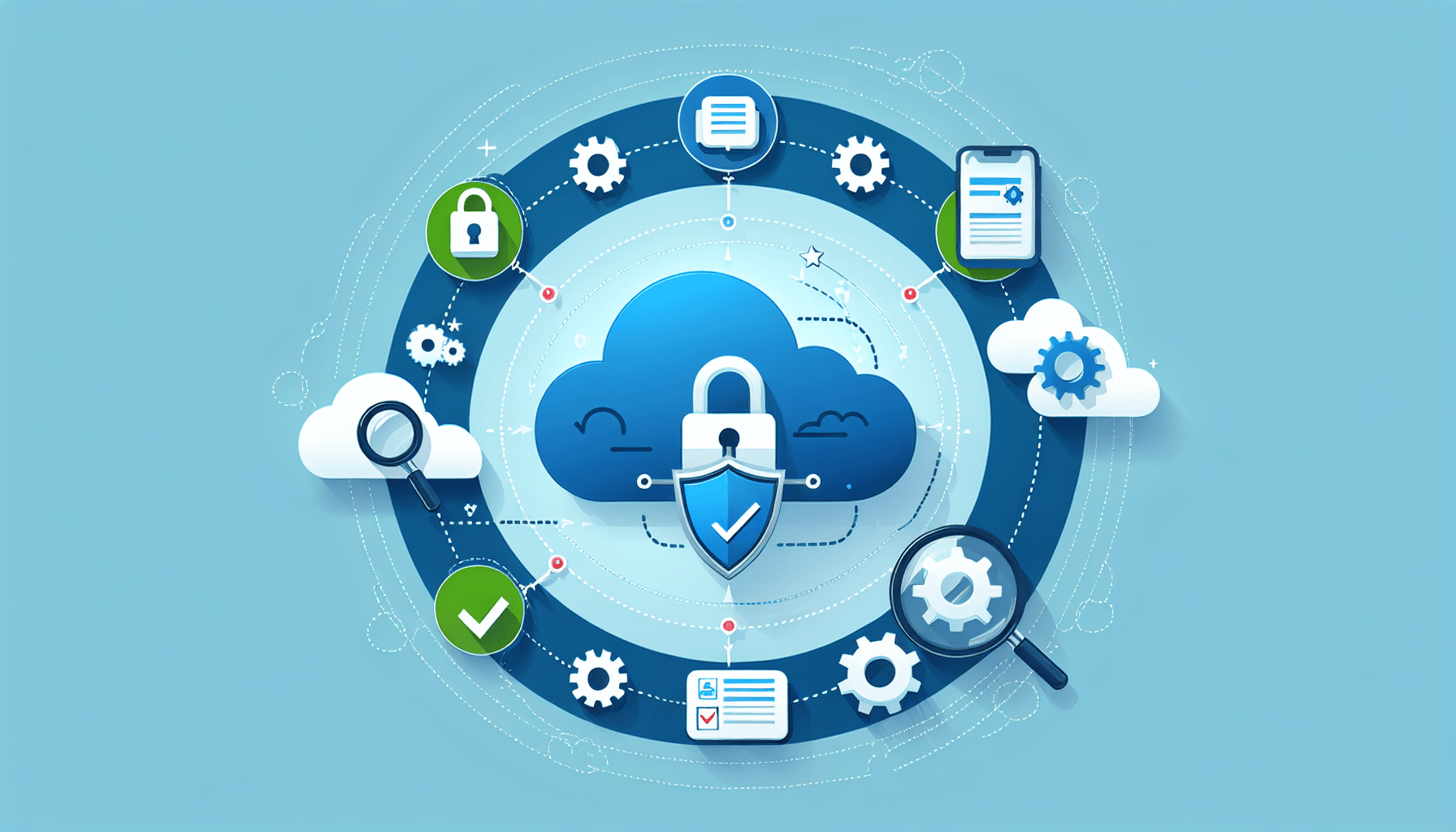In today’s rapidly evolving digital landscape, ensuring the security of cloud-based systems is paramount. With the growing reliance on cloud computing, organizations must effectively identify and mitigate potential risks to safeguard sensitive data and maintain the trust of their stakeholders. This article explores the best practices for conducting cloud security risk assessments, providing practical insights and guidance to help you proactively evaluate and address vulnerabilities in your cloud environment. By following these recommended practices, you can enhance your organization’s security posture and confidently navigate the complexities of cloud computing.

1. Understand the Importance of Cloud Security Risk Assessments
Cloud Security Risk Assessments play a crucial role in ensuring the safety and integrity of data stored in cloud environments. With the increasing adoption of cloud computing, it is essential for organizations to assess and mitigate potential risks inherent to this technology. By conducting a thorough risk assessment, you can gain insights into the vulnerabilities and threats specific to your cloud infrastructure, enabling you to implement appropriate security controls and countermeasures.
1.1 Definition of Cloud Security Risk Assessments
A Cloud Security Risk Assessment involves the systematic identification, evaluation, and prioritization of risks associated with the use of cloud services. It encompasses the evaluation of cloud security controls, identification of vulnerabilities, and assessment of the cloud service provider’s security practices. The ultimate goal is to identify and mitigate risks that could compromise the confidentiality, integrity, and availability of data and applications hosted in the cloud.
1.2 Benefits of Conducting Cloud Security Risk Assessments
Conducting regular Cloud Security Risk Assessments offers numerous benefits to organizations, including:
-
Increased awareness: By assessing cloud security risks, you develop a deeper understanding of the potential threats and vulnerabilities specific to your cloud environment. This awareness allows you to make informed decisions about security controls and countermeasures.
-
Proactive risk management: Cloud Security Risk Assessments help organizations proactively identify areas of weakness in their cloud infrastructure. This enables timely remediation efforts, reducing the likelihood of security incidents and associated damages.
-
Compliance with regulations: Many industries have strict regulatory requirements regarding data security. Conducting regular risk assessments ensures compliance with these regulations, minimizing the risk of non-compliance penalties.
-
Enhanced stakeholder confidence: Through the implementation of robust risk assessment practices, organizations can demonstrate their commitment to data security and gain the trust and confidence of customers, partners, and stakeholders.
2. Establish Clear Objectives for the Assessment
To conduct an effective Cloud Security Risk Assessment, it is crucial to establish clear objectives that align with the organizational goals and priorities. This step sets the direction for the assessment and ensures that the process is focused and outcome-oriented.
2.1 Identify the Purpose of the Assessment
Before embarking on a Cloud Security Risk Assessment, define the purpose that will guide the assessment process. Common purposes of such assessments include:
- to identify and prioritize cloud security risks,
- to evaluate the effectiveness of existing security controls,
- to assess the compliance of the cloud service provider with security standards, and
- to provide recommendations for improvement and risk mitigation.
Identifying the purpose allows you to tailor the assessment to meet the specific needs of your organization.
2.2 Determine the Scope of the Assessment
Defining the scope of the assessment is another critical step in the process. The scope outlines the boundaries of the assessment, specifying which cloud services, applications, and infrastructure components will be included.
Consider factors such as the size and complexity of your cloud environment, the sensitivity of the data hosted, and the potential impact of a security breach. Also, take into account any relevant industry regulations or contractual obligations that may affect the scope of the assessment.
By clearly defining the scope, you ensure that the assessment is comprehensive and covers all relevant areas of your cloud infrastructure.
3. Define the Assessment Methodology
To conduct a Cloud Security Risk Assessment effectively, you need to define a structured methodology that guides the assessment process. This methodology provides a systematic approach to identify, evaluate, and mitigate risks in your cloud environment.
3.1 Select the Appropriate Assessment Framework
Choosing the right assessment framework is essential for conducting a thorough and standardized risk assessment. Several widely recognized frameworks can serve as a foundation for your assessment, such as NIST SP 800-30, ISO 27005, or CSA Cloud Controls Matrix.
Evaluate these frameworks based on their alignment with your organization’s goals, industry-specific requirements, and the depth of coverage they provide. Selecting an appropriate framework ensures consistency and facilitates effective risk assessment.
3.2 Identify the Assessment Tools and Techniques
Alongside the assessment framework, you need to identify and utilize appropriate tools and techniques to support your risk assessment process. These tools can aid in identifying vulnerabilities, evaluating controls, and analyzing the overall security posture of your cloud environment.
Consider using vulnerability scanners, penetration testing tools, and risk assessment software to automate various aspects of the assessment. Additionally, leverage industry best practices and expert guidance to ensure the accuracy and effectiveness of the assessment techniques employed.
By selecting the right assessment tools and techniques, you can enhance the efficiency and accuracy of your Cloud Security Risk Assessment.
4. Identify and Prioritize Cloud Security Risks
Identifying and prioritizing cloud security risks is a crucial step in the assessment process. By understanding the specific risks your organization faces, you can focus resources and efforts on the most critical areas.
4.1 Conduct a Cloud Risk Identification Exercise
To identify cloud security risks effectively, engage key stakeholders from various departments, including IT, security, legal, and compliance. Conduct workshops, interviews, and brainstorming sessions to gather insights on potential risks and threats associated with your cloud environment.
Consider risks related to data breaches, unauthorized access, data loss, service outages, and regulatory non-compliance. Document these risks in a structured manner, noting their potential impact and probability.
4.2 Evaluate and Prioritize Identified Risks
Once you have identified potential risks, evaluate them based on predefined criteria such as likelihood, impact, and detectability. This assessment allows you to prioritize risks and allocate resources accordingly.
Consider the potential consequences of each risk and how it aligns with your organization’s risk tolerance. Some risks may require immediate attention, while others may be accepted or transferred through insurance or contractual mechanisms.
By evaluating and prioritizing risks, you ensure that mitigation efforts are focused on the most significant threats to your cloud environment.

5. Assess Cloud Security Controls and Countermeasures
To ensure the effectiveness of your cloud security measures, it is essential to assess the controls and countermeasures in place. This evaluation helps identify gaps and weaknesses that may expose your cloud environment to potential risks.
5.1 Evaluate the Effectiveness of Existing Controls
Review and assess the effectiveness of the security controls implemented in your cloud environment. Consider controls related to access management, encryption, monitoring, incident response, and backup and recovery.
Assess the implementation, configuration, and documentation of these controls to determine if they adequately address the identified risks. Look for any inconsistencies, vulnerabilities, or weaknesses that may compromise the security of your cloud environment.
5.2 Identify Gaps and Weaknesses in Cloud Security
Based on the evaluation of existing controls, identify gaps and weaknesses that need to be addressed. These gaps may be related to control implementation, configuration, or coverage.
Determine the root causes of these gaps and assess their impact on your cloud security posture. Use this information to develop action plans and prioritize remediation efforts.
By assessing cloud security controls and identifying vulnerabilities, you can strengthen your cloud environment’s ability to withstand potential risks.
6. Conduct a Vulnerability Assessment
A vulnerability assessment is a critical part of a comprehensive Cloud Security Risk Assessment. It involves scanning your cloud infrastructure for vulnerabilities and analyzing the effectiveness of vulnerability management processes.
6.1 Scan for Vulnerabilities in Cloud Infrastructure
Utilize vulnerability scanning tools to scan your cloud infrastructure for known vulnerabilities. These tools identify potential weaknesses in your systems, applications, and configurations that can be exploited by attackers.
Document the identified vulnerabilities along with their severity ratings. Classify the vulnerabilities based on their potential impact and exploitability.
6.2 Assess Vulnerability Management Processes
Evaluate the effectiveness of your vulnerability management processes, including the identification, remediation, and tracking of vulnerabilities. Consider factors such as patch management, vulnerability scanning frequency, and incident response procedures.
Identify any gaps or weaknesses in these processes and develop strategies to address them. This may involve improving communication and coordination between teams, automating vulnerability scanning processes, or implementing vulnerability management tools.
By conducting a vulnerability assessment, you can proactively identify and resolve potential weaknesses in your cloud infrastructure.
7. Perform a Penetration Testing
In addition to vulnerability assessments, conducting penetration testing is crucial to validate the effectiveness of your cloud security measures and identify potential vulnerabilities that may be missed by automated scanning tools.
7.1 Engage Ethical Hackers to Test Cloud Security
Penetration testing involves engaging ethical hackers who attempt to exploit vulnerabilities in your cloud infrastructure through controlled and authorized simulated attacks. This process mimics real-world scenarios, allowing you to assess the resilience of your cloud environment against various threats.
By employing expert penetration testers, you can identify potential security weaknesses and validate the effectiveness of existing controls. Ethical hackers can also provide insights into potential attack vectors and suggest measures to further enhance your cloud security.
7.2 Analyze Results and Remediate Identified Vulnerabilities
After conducting the penetration testing, carefully analyze the results and prioritize the remediation of identified vulnerabilities. Classify vulnerabilities based on their potential impact and exploitability, and develop action plans to mitigate them.
Work closely with the penetration testing team to understand the root causes of vulnerabilities and implement appropriate remediation measures. This may involve patching systems, refining access controls, or revisiting security configurations.
By performing penetration testing, you can gain valuable insights into your cloud environment’s security posture and take proactive steps to strengthen it.
8. Review Cloud Service Provider (CSP) Security Practices
Assessing the security practices of your Cloud Service Provider (CSP) is essential to ensure the overall security and compliance of your cloud environment. Understanding their security policies, procedures, and compliance with industry standards allows you to make informed decisions about their reliability as a trusted partner.
8.1 Assess CSP’s Security Policies and Procedures
Review the security policies and procedures of your CSP to understand how they protect your data and ensure the availability and integrity of their services. Evaluate aspects such as data privacy, incident response, access controls, and disaster recovery.
Assess the alignment of the CSP’s security practices with industry best practices and relevant standards such as ISO 27001 or SOC 2. Look for any gaps or weaknesses that may pose a risk to your cloud environment.
8.2 Evaluate CSP’s Compliance with Security Standards
Determine the extent to which your CSP complies with industry-recognized security standards and regulations. Evaluate their certifications, attestations, or audit reports to verify their adherence to prescribed security controls and processes.
Consider assessing their compliance with standards specific to your industry, such as HIPAA for healthcare organizations or PCI DSS for businesses handling credit card data. Ensure that your CSP meets or exceeds the required security standards to mitigate risks associated with non-compliance.
By reviewing your CSP’s security practices and compliance, you can make informed decisions about their suitability as a reliable and secure cloud service provider.
9. Document Findings and Recommendations
To ensure the effectiveness and continuity of the risk assessment process, it is crucial to thoroughly document the findings, recommendations, and action plans resulting from the assessment.
9.1 Record Assessment Results and Identified Risks
Create a comprehensive report documenting the assessment results, including the identified risks, vulnerabilities, and gaps in security controls. Clearly outline the severity and potential impact of each risk to provide a holistic view of the security landscape.
Include supporting evidence, such as vulnerability scan reports, penetration testing findings, and documents related to the assessment methodology. This documentation will serve as a valuable reference for future risk assessments and audits.
9.2 Provide Recommendations for Mitigation and Improvement
Accompany the assessment report with a detailed set of recommendations for mitigating identified risks and improving the overall security posture of your cloud environment. Ensure that the recommendations are actionable and aligned with the goals and resources of your organization.
Prioritize the recommendations based on severity, impact, and feasibility. Include timelines, responsible parties, and success criteria for monitoring the implementation and effectiveness of each recommendation.
By documenting findings and recommendations, you establish a roadmap for addressing and mitigating identified risks, ensuring continuous improvement in your cloud security practices.
10. Continuously Monitor and Update the Risk Assessment
To maintain the effectiveness of your Cloud Security Risk Assessment, adopt a proactive approach to continuous monitoring and updating.
10.1 Establish Ongoing Monitoring Mechanisms
Implement continuous monitoring mechanisms to detect and respond to emerging threats and vulnerabilities in your cloud environment. Consider adopting security information and event management (SIEM) tools, log analysis systems, and intrusion detection systems to enhance your monitoring capabilities.
Regularly review security logs, conduct periodic vulnerability scans, and monitor relevant threat intelligence sources to stay informed about potential risks and industry trends. Adopting a proactive monitoring strategy allows you to detect and mitigate security incidents in a timely manner.
10.2 Regularly Review and Update the Risk Assessment
Cloud environments and associated risks evolve over time, so it is essential to periodically review and update your Cloud Security Risk Assessment. Conduct reviews at least annually or whenever significant changes occur in your cloud infrastructure or threat landscape.
Revisit the assessment methodology, objectives, and scopes to ensure their relevance and effectiveness. Incorporate lessons learned from security incidents, industry best practices, and changes in regulatory requirements.
By regularly reviewing and updating the risk assessment, you ensure that your cloud security practices remain robust and aligned with the evolving threat landscape.
In conclusion, conducting a comprehensive Cloud Security Risk Assessment is a critical aspect of maintaining the integrity and security of your organization’s cloud environment. By understanding and implementing the best practices outlined in this article, you can proactively identify and mitigate potential risks, ensuring the confidentiality, integrity, and availability of your data and applications in the cloud.



